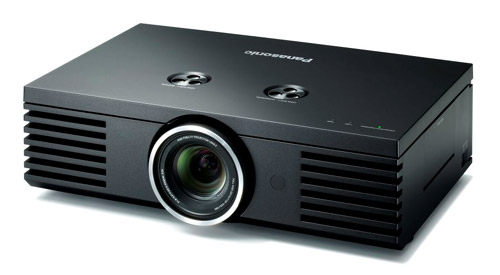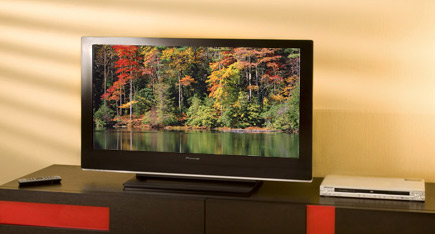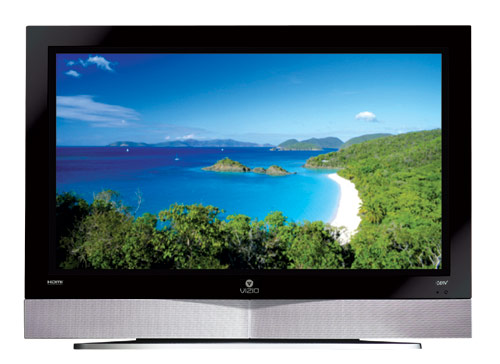HDTV Formats and Resolutions: The Numbers Game
Note: This article has been updated for 2011 to accomodate the latest technology and terms.
It used to be that only the affluent could afford a flat screen TV. When a 42-inch flat panel plasma or LCD TV cost over $5,000, those who could afford one wouldn't think twice about dropping another $500 to have it correctly installed and hooked up. But now that 42-inch and larger flat panel TVs have dropped into the $1000 (and below) range, there are a surplus of HDTVs coming home, and a deficit of information on how to get them installed and connected properly.
The fact is, a good installer or home theater specialist will allow anyone to get the most out of their HDTV. Proper connection to existing components (DVD players, cable boxes, etc.), calibration and good advice from a home theater professional can make or break your experience with a new flat panel or rear projection HDTV or 3D TV. If you can afford it, hire a pro. But for those who have spent their entire budget (and then some) on that fancy new flat panel, or those who simply like to "DIY," this series of articles will help make sure you get the most of your big screen investment.
720p vs. 1080i vs. 1080p - How Many Pixels Do You Really Need?
There is a lot of confusion over what constitutes "high definition" as far as display devices go. The bottom line is that, according to the Consumer Electronics Association, in their news release of August, 2000, any widescreen (16:9) display device (TV, monitor or projector) that has a native vertical resolution of 720 pixels (picture elements) progressive or 1080 lines interlaced (or more) is considered "high definition-enabled" or "HDTV Ready."
The 720 line progressive and 1080 line interlaced specifications come from two of the most common signal formats used in broadcast HDTV - 720p and 1080i. So, if a display device has at least 720 pixels of vertical resolution displayed progressively then it can display a high definition 720p signal with no loss in detail and it is qualified to be called "high definition" (HD). Higher resolutions than 720P exist of course, but this is the minimum required.
To determine whether your chosen display is able to reproduce HDTV signals properly, take a look at its rated resolution, sometimes called "native panel resolution." A flat panel TV can only have one native panel resolution as this is the number of actual pixels that make up the screen. You'll frequently see numbers like 1024x768 (in 42-inch plasmas), 1280x720 (in LCD and DLP rear and front projection sets), 1366x768 (in 23-inch+ LCDs and 50-inch+ plasmas), and 1920x1080 (in newer LED, LCD and plasma flat panels, DLP, LCD, LCOS and SXRD projection TVs, both rear and front projection). All of the above resolutions are considered high definition enabled or "HD-Ready."

Generally speaking, the higher the native panel resolution, the more detail you'll see in the picture because there are more "dots" to reproduce the fine details of the picture. When you get into larger screen sizes (50 inches or above), then the pixel structure can become more apparent to the naked eye on lower resolution TVs, even at average viewing distances. This is visible as "grain" in the image. The more pixels you have to make up the image, the less grain you will see.
So if you're going really big, then more pixels are usually better. But other differences between these various screen display technologies (plasma, LED, LCD, DLP, etc.) are generally so great that choosing a display based on the resolution specification alone is a bad idea. In recent years, manufacturers have started inflating the claimed contrast ratios as well, with numbers of over 1,000,000:1 now commonplace on many flat panel TVs. It is important to take these ratings with a grain of salt as there is no adopted standard of how contrast and brightness numbers are measured from set to set or from brand to brand.
There are a number of factors that affect overall picture quality: color reproduction, perceived contrast, panel response times, the ability to handle fast motion, brightness and reproduction of black levels are all important, in addition to resolution. And these elements are a bit more elusive to measure accurately. Choose the television that looks best to you (or earns the highest recommendations from sources you trust) and don't worry too much about the numbers.
Panel Resolution vs. Input Formats
In addition to the native panel resolution, your TV will also have ratings for "input resolution support" or "input formats." This relates to the different types of inputs or source devices you can connect to your HDTV. Virtually all digital TVs or HDTVs can accept digital and analog TV signals in a variety of different input resolutions and will convert these internally to their native panel resolutions in order to display the signal properly. But not all TVs support all HDTV formats.
There are actually 18 different resolution formats that comprise the ATSC standard, but only a few are in wide-spread use in broadcasting and/or in source devices such as HD satellite and cable set-top boxes and Blu-Ray Disc players.
These resolution measurements include a number (the vertical resolution) followed by a letter ("i" for "interlaced," "p" for "progressive"). An "interlaced" image means that the image is built in two "fields" each comprised of half of the total lines of resolution. These fields are interlaced or stitched back together in order to display one single image or "frame." This process happens so quickly that the human eye doesn't notice it, but an interlaced image can be plagued by problems such as diagonal lines that look jagged ("jaggies") as well as lower perceived detail.
Image interlacing was adopted early in the days of television as a way of saving transmission bandwidth - you can fit more channels into the available bandwidth if you interlace the image. A "progressive" image, on the other hand, is built on the screen all at once (no interlacing), so it can generally do a better job of reproducing a picture.
Nearly all modern digital displays support input resolutions of 480i (broadcast TV and DVD), 480p (DVD or digital cable), 720p (HDTV) and 1080i (HDTV). Many newer models also support 1080p, which is a resolution of 1920x1080 pixels, presented in progressive format - this is the highest resolution in the ATSC high definition standards.
For example, most flat panel HDTVs with a native panel resolution of 1366x768 pixels (sometimes called "768p") can accept high definition 1080i (1920x1080 interlaced) signals from an HD set top box, streaming media player, or Blu-Ray Disc player. The TVs take these roughly 2 million pixels from the source component and "scale" or "re-map" the image to fit the roughly 1 million pixels available on the TV's panel. This is accomplished by a video scaler built into the TV. There is some loss in detail, but the results can still be excellent if done properly.
Some (but not all) HDTVs can even accept a "Full HD" 1080P signal and either display this at the native resolution, or scale it to fit the panel. The ability to accept a 1080P input signal is getting more and more common, but the lack of this feature does not mean that your TV is already obsolete.

Currently only the very latest set-top boxes and Blu-Ray disc players can generate a 1080p output (1080p is not currently used in broadcast or cable HDTV). And if your new panel does not support 1080p inputs, then you need not fret because all of the new 1080p-capable source components (streaming set-top boxes, Blu-ray players, etc.) allow you to change the output format to 1080i, 720p, or even 480p or 480i so they're compatible with virtually any modern display device. Support for 1080P native input resolutions is always best, but you can get excellent results even without it.
HDTV vs. HD-Ready TV
Now assuming your display is able to display a high definition signal (720p or above), there is a very simple feature that differentiates "HDTV" from "HD-Ready" TV: a tuner, or more specifically an "ATSC" tuner. ATSC stands for "Advanced Television Standards Committee" (as opposed to "NTSC" which represents the older "National Television Standards Committee"). ATSC is simply a short-hand way of referring to a digital tuner that can receive and tune in HDTV signals that are broadcast (for free) over the air.
Some HDTVs also include a "QAM" digital tuner, which can tune in digital cable signals (including HDTV over cable) without the need for a cable box. A television which does not include an ATSC and/or QAM digital tuner (but does have the rated resolution to reproduce a high defintion signal) is considered "HD-Ready." It's not a true HDTV without a tuner. But does that matter?

Do you really need an HD (ATSC and/or QAM) tuner built into your television? The answer depends on how you get your TV channels delivered into your home. If you currently use an antenna to watch TV, then you definitely need a tuner. If the ATSC tuner is not built into your TV, then you can always buy an external ATSC tuner such as a Channel Master CM-7000PAL OTA DVR or something similar.
But if you get your television content from cable, fiberoptic (e.g., "FiosTV") or satellite, then you really do not need a built-in ATSC tuner, because the box you get from your provider (satellite box, cable box or Fios box) includes its own tuner. Just plug these boxes into your new set's component video or HDMI input, and you're good to go.
HD Starts at the Source
If you are upgrading from an older non-HD television to a new HD-ready television or HDTV, then you will need a new set-top box from your provider in order to watch real high-resolution high definition TV programs. Most providers charge only a slight premium for the high definition box, and most providers offer a high definition "DVR" (digital video recorder) for a few dollars more. HD DVRs allow you to actually record shows in high definition and watch these shows at your leisure.
Of course, it is possible to hook up an older cable or satellite box into a new TV (using a single composite video cable or S-Video cable, plus analog audio cables or using a coax cable), but you will not get true high definition programs on your HDTV. In fact, with all the glorious resolution and larger screen size of your new HDTV, standard definition television sources may just reveal themselves to be somewhat less than spectacular if not virtually unwatchable. So get a high definition source and get one now!
A Few Words about 3D TV
When we first wrote this article, "3D TV" still meant those awful red and blue glasses that did not offer a very enjoyable 3D viewing experience. Now, in 2011 many HDTVs offer high quality active or passive 3D viewing as an additional feature. The same rules about resolution apply to 3D TVs as to 2D TVs, and there are only a few additional caveats regarding the actual hook-up that we will cover in Part II of this article.
OK. Crystal clear on resolutions now? Continue to Part II for details on how to hook up your HDTV, including how to pick up free HDTV signals over the air.
Articles in This Series: